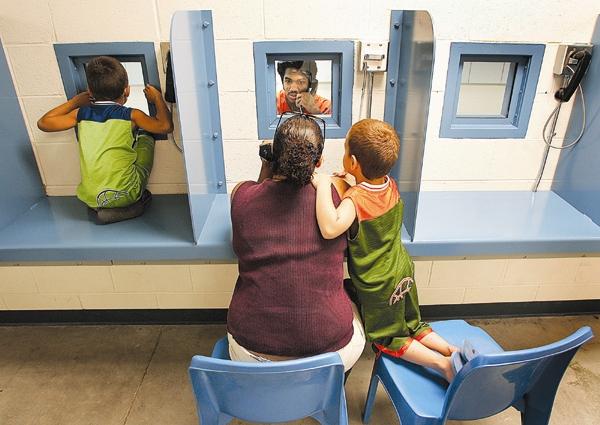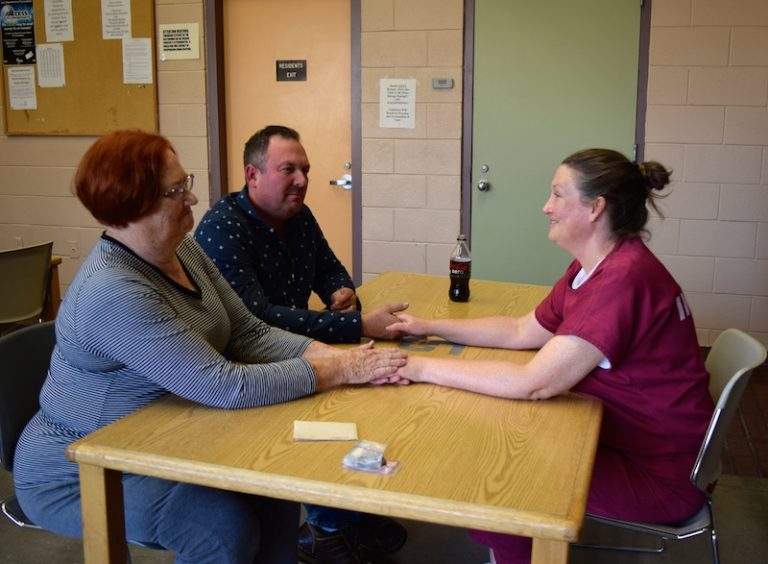The Simple Guide to Visiting an Inmate for the First Time
Updated on 9/27/2023
When a loved one ends up in jail or prison, one of your first thoughts will probably be “When will I get to see them again?”
Of course, if you’ve never visited an inmate before, the thought of doing so may be intimidating – even outright frightening.
However, you can alleviate these fears by understanding what to expect during inmate visitation and being prepared for every step of the process. The following guide will tell you everything you need to know about what to expect when visiting an incarcerated friend or family member.
Prior to visiting an inmate in prison, you must know
How To Get Approved To Visit An Inmate
Before you ever step foot inside the institution, you’ll need to complete some basic paperwork and make sure you’re following the correct policy.
If you do not follow these measures exactly as directed by the administration, you risk not being permitted to visit your loved one at all.
Visiting an incarcerated loved one can be a daunting process, but understanding the steps for getting approved can help ease the way.
With some preparation and patience, you can successfully navigate the visitation system.
- Research the Facility’s Policies
The first key step is researching the specific visitation policies and procedures for the facility where the inmate is housed.
Prisons and jails each have their own regulations on visitation application requirements, approved visitor lists, dress codes, visit schedules, and more.
Check the facility’s website or call their office to learn their guidelines.
- Get on the Approved Visitors List
In order to get approval to visit, you’ll need to be placed on the inmate’s approved visitors list. The inmate must submit your name, address, date of birth, and relationship to them to the facility.
The process may include completing request forms and sending copies of your government-issued ID. Approvals for minors usually require consent forms from their legal guardian as well.
- Pass the Background Check
Facilities need to screen all potential visitors through background checks as a safety measure.
Local jails and police stations can decide to bar visitation to individuals with criminal records, a history of drug abuse, or other red flags.
While a clean background helps your chances, minor offenses don’t automatically disqualify you. Be honest in disclosing your history.
- Know What to Expect
Get familiar with the facility’s dress code, security procedures, and visitation hours.
Stick closely to the rules - arriving late, wearing prohibited clothing items or bringing banned objects could get your visitation revoked.
Most visits will be non-contact only, with a glass partition separating you and the inmate. Visitors should expect to go through screening checkpoints upon arrival and may need to show ID.
- Sign Up for Scheduled Visits
Many facilities now require you to schedule visitation time slots ahead of your visit in order to manage capacity restrictions.
Sign up for an available time online or by phone as early as possible, as slots can fill up quickly. Make sure to be on time for your appointment.
- Have Patience
The entire approval process can take some time, sometimes weeks or months depending on the facility.
Be patient and persistent in following up if you don’t hear back right away.
Reach out to the facility contact if you need to provide additional documentation or clarify any issues with your request to help move it along.
With some diligent preparation, understanding of the regulations, and patience in navigating the red tape, getting approved for inmate visitation is very doable.
Staying on top of the process and policies makes for a smoother visitation experience. Most importantly, enjoy the chance to visit your loved one when approved!
Know Who’s Allowed for Inmate Visitation
First things first, all prisons have rules dictating who is actually allowed to visit an inmate during specified hours. In general, this list includes:
- Immediate family members
- Approved relatives
- Friends (usually an approved list of fewer than 10 individuals)
- Religious leaders
- Sponsors
- Employers
- Attorneys
On the other hand, there are a number of reasons you may not be allowed to visit a loved one in prison, such as if you have an outstanding warrant, you have an active order of protection against you, you’re currently on probation or parole, or you’re deemed a security risk.
Although individuals who have previously been convicted of felonies may face a tough time being admitted as visitors to a prison, they’ll be assessed on a case-by-case basis.
Information to Provide to Visit an Inmate
Once you are sure you meet the criteria listed above, you’ll need to provide the institute with information about yourself, such as your full name, birthdate, address, and other contact information.
The inmate you’re visiting will fill out a form denoting you as an approved guest, and the form will then be sent to your home address for you to complete. You can either mail the form back to the prison or return it in person – just make sure to do so long in advance of your planned visit.
How to Dress to Inmate Visitation
When visiting an inmate in prison, you should take special care to ensure you follow the dress code exactly as it’s dictated. As mentioned, failure to adhere to any of the prison’s guidelines will almost certainly disqualify you from being able to see your friend or family member during the allotted time.
Though dress codes vary depending on the specific institute, the following rules generally apply:
- No hats or extraneous garments
- No revealing clothing, including spaghetti straps, short skirts, or tank tops
- No shorts
- No clothing that resembles inmates’ clothing
When considering what to wear when visiting an inmate, err on the side of tastefulness.
You don’t want something silly like the way you’re dressed to be the reason your loved one doesn’t get to see you.
Arriving to the Prison for Inmate Visitation
Once you arrive at the prison, you’ll be subjected to a number of procedures before you’re actually allowed to see your loved one. These procedures are all in the name of safety, so – again – it’s important that you adhere to the rules exactly as they’re designated.
 (source)
(source)
First, you’re advised to arrive about 15-20 minutes early. This will give you enough time to fill out the necessary paperwork and go through the numerous security clearances as you enter the grounds. Arriving early is especially important your first time visiting someone in jail. The paperwork process is less exhausting on subsequent visits.
If you arrive late, your time with your loved one will simply be cut short. (On the other hand, arriving too early will cause an inconvenience to prison staff. Arriving 20 minutes early should give you more than enough time to do what you need to do.)
As mentioned, you should expect to have your person and vehicle searched once you enter the parking lot, and again as you enter the actual facility. You’ll likely be asked to remove any jewelry you may be wearing, your belt, and anything in your pockets.
Generally, you’re allowed to keep the following items with you during your visit:
- ID/License
- Glasses
- Money for vending machine snacks
- Diaper and bottle if you bring a child
Most other objects, including your keys, must be stored in a locker that will be provided.
There are, of course, objects you shouldn’t bring, as well, such as:
- Medication of any sort
- Cigarettes or tobacco-related products
- Anything that can be considered or used as a weapon
- Illicit substances or materials
You’ll likely be able to leave medication or tobacco products in your car, but it is probably best to just leave them at home. As for illegal instruments or substances, since you’ll be consenting to a lawful search upon entering the grounds, possession of any of the sort may ultimately lead to criminal charges against you.
The smoother your intake process goes, the quicker you’ll be able to see your loved one. Do everything you can on your end to make sure this happens.
During Inmate Visitation
Once you’re finally allowed to actually see your friend or family member, it’s important to remember you’re not at home or the mall. For security reasons, a number of seemingly innocuous actions are not tolerated while visiting a prisoner and may be cause for visitation to end prematurely.
 (source)
(source)
You should always maintain a professional demeanor during your visit. Speak in a lower tone of voice, stay calm, and be considerate of other visitors, inmates, and staff members. Boisterous laughter or anything of the sort will almost always cause staff to end your visit early.
You’ll be relegated to a specific table where your visit will take place, and you must not move from your assigned seat throughout the visitation. In general, you’ll be sat across from your loved one with a visible amount of physical space between the two of you. Any excess movement or fidgeting will arouse a guard’s suspicion, and generally will not be tolerated.
You’ll be allowed to give a hug, handshake, or kiss “hello” and “goodbye” at the beginning and end of your visit, but nothing more. Again, a pat on the shoulder may seem innocuous to you as a friendly visitor with nothing to hide, but, for security reasons, such fraternizing is not allowed.
Inmate visitation lasts anywhere from 15-30 minutes. Once time is up, you’ll be allowed to say a quick goodbye and will be escorted to your locker to gather your belongings, then will be brought out of the facility.
The amount of inmate visitations you’re allowed to make depend on a variety of factors, such as an institute’s policy, your loved one’s behavior, and the administration’s discretion. However, federal law dictates that inmates must have at least four hours of total visitation time per month. Depending on your relationship to the inmate, you may be able to see them more often than you had initially hoped.
Conclusion
As mentioned, visiting an incarcerated loved one for the first time can be a nerve-wracking experience.
But, as long as you understand exactly what to expect before and during your visit, you’ll be able to focus on the positive aspects of getting some much-needed facetime with your imprisoned friend or family member.
And, as long as you follow the regulations of the institution, you should be welcomed back as much as lawfully allowed.
Have you ever visited a loved one in jail or prison? What else should first-time visitors expect that we may have missed? What advice can you give those who are nervous about entering a prison facility as a guest?
We love hearing from our readers. Let us know if you have anything to add!